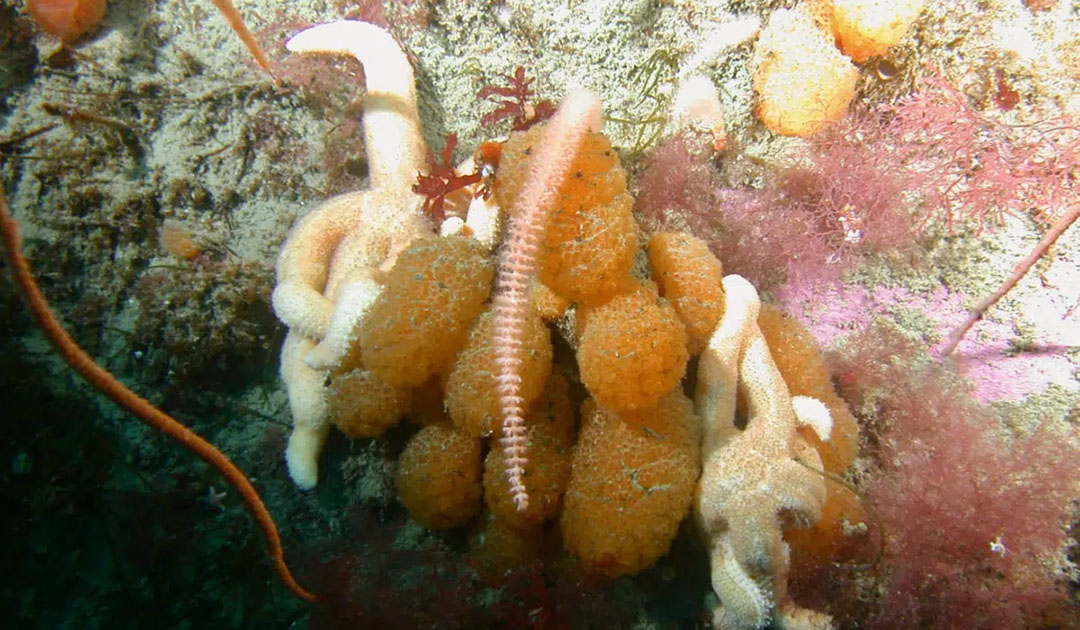
Nature is home to countless active substances, many of which have been used to heal wounds and diseases from time immemorial. One of them is Palmerolide A, which was found in the Antarctic sea squirt Synoicum adareanum and is successfully used in the therapy against melanoma, one of the most dangerous types of skin cancer. In a new study published in the journal mSphere, a team of US researchers has succeeded in identifying the origin of Palmerolide A: A bacterium that lives in sea squirts produces the compound.
Sea squirts, or ascidians, are sessile seafloor dweller and, like other marine invertebrates, harbor an abundance of diverse microbes that are symbiotically linked to their hosts through the exchange of metabolites. As early as 2006, the compound Palmerolide A was isolated for the first time from the Antarctic sea squirt species Synoicum adareanum, which occurs around Anvers Island west of the Antarctic Peninsula. But only now, after more than ten years of research, have the scientists been able to trace the compound back to its source, the new and previously unstudied bacterial genus Candidatus Synoicihabitans palmerolidicus.
“We have long suspected that Palmerolide A is produced by one of the many species of bacteria that live in this ascidian host species, S. adareanum,” explains lead author Alison Murray, Ph.D., research professor of biology at the Desert Research Institute. “Now we’ve actually been able to identify the specific microbe that produces this substance, which is a big step toward developing a naturally derived treatment for melanoma.”
After the research team had already identified the 21 most important bacterial species living in the sea squirt Synoicum adareanum in a previous study, the current investigations focused on finding out which species of the core microbiome produce Palmerolide A by means of genetic analyses.
“This is the first time that we’ve matched an Antarctic natural product to the genetic machinery that is responsible for its biosynthesis”, Murray said. “As an anti-cancer therapeutic, we can’t just go to Antarctica and harvest these sea squirts en masse, but now that we understand the underlying genetic machinery, it opens the door for us to find a biotechnological solution to produce this compound.”
“Knowing the producer of palmerolide A enables cultivation, which will finally provide sufficient quantity of the compound for needed studies of its pharmacological properties,” added Bill J. Baker, professor of chemistry at the University of South Florida.
However, some questions remain unanswered, such as the distribution of Synoicum adareanum and its symbionts in the Southern Ocean, or what role Palmerolide A plays in the ecology of the sea squirt.

The development of symbiotic relationships with microorganisms is an essential survival strategy for sea squirts and other marine invertebrates such as sponges and corals in the harsh conditions of Antarctica. The microbes provide their hosts with photoprotective pigments, chemical defense substances or compounds that enable bioluminescence. The compounds produced by these bacteria may have medicinal and biotechnological applications useful to humans in science, health and industry. Palmerolide A is one of many examples that still need to be further researched or discovered.
“Throughout the course of disentangling the many genomic fragments of the various species in the microbiome, we discovered that this novel microbe’s genome appears to harbor multiple copies of the genes responsible for palmerolide production,” said Dr. Patrick Chain, senior scientist and laboratory director at Los Alamos National Laboratory. “However the role of each copy, and regulation, for example, are unknown. This suggests palmerolide is likely quite important to the bacterium or the host, though we have yet to understand it’s biological or ecological role within this Antarctic setting.”
“This is a beautiful example of how nature is the best chemist out there,” Murray added. “The fact that microbes can make these bioactive and sometimes toxic compounds that can help the hosts to facilitate their survival is exemplary of the evolutionary intricacies found between hosts and their microbial partners and the chemical handshakes that are going on under our feet on all corners of the planet.”
Julia Hager, PolarJournal





